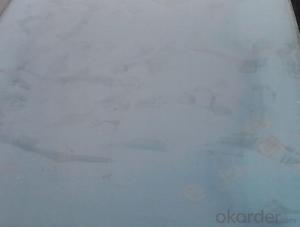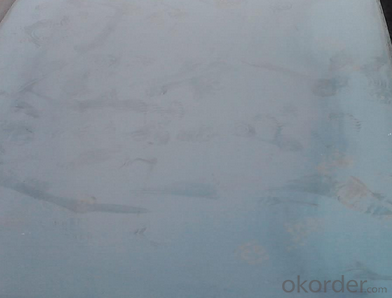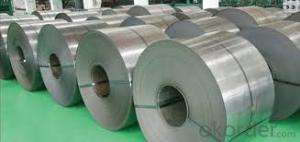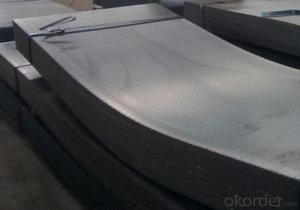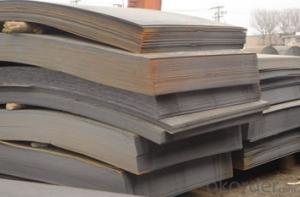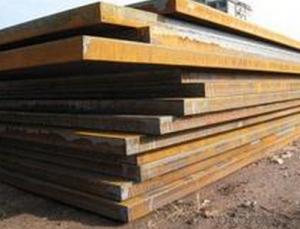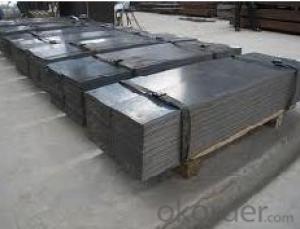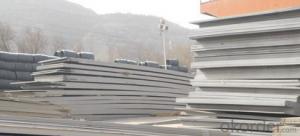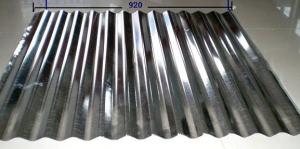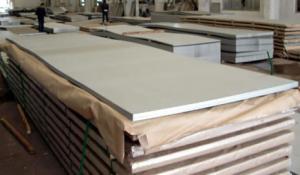Hot Rolled Carbon Steel Plate,Carbon Steel Sheet 20R, CNBM
- Loading Port:
- Qingdao
- Payment Terms:
- TT OR LC
- Min Order Qty:
- 10 pc
- Supply Capability:
- 30 pc/month
OKorder Service Pledge
OKorder Financial Service
You Might Also Like
Quick Details
| Standard: | AISI, ASTM, GB, JIS | Grade: | Q195,Q235,Q345,A36,C45 | Thickness: | 1.0-30MM |
| Model Number: | Q235,Q195,Q345 | ||||
| Type: | Steel Plate | Technique: | Hot Rolled | Surface Treatment: | Coated |
| Application: | Ship Plate | Special Use: | Silicon Steel | Width: | 30-2000mm |
| Length: | as your requirement | standard: | hot rolled | Surface: | Anti-rust oil |
Packaging & Delivery
| Packaging Details: | seaworthy packages or as customers' require |
| Delivery Detail: | within 15 days after the advance payment |
Hot rolled steel plate
1 carbon steel plate 3mm thick General information
| Product name | Type | Specification | Implementation of GB | ||
| thick | wide | long | |||
| Carbon structural steel | Q195,Q215, Q235A,Q235B, Q235C,Q255, Q275 | 4-120 | 1500-4500 | 6000-12000 | GB/T700-2006 |
| Low-alloy structural steel | Q295,Q345A, Q345B,Q2345C | 4-120 | 1500-4500 | 6000-12000 | BG/T1591-1994 |
| Quality carbon structural stee | 30-50 | 4-120 | 1500-4500 | 6000-12000 | BG/T699-1999 |
| Ship steel | CCSA,CCSB | 4-120 | 1500-4500 | 6000-12000 | materials and welding condition |
| CCSAH32,CCSAH36 CCSDH32,CCSDH36 | 4-120 | 1500-4500 | 6000-12000 | materials and welding condition or GB 712-2000 | |
| Boiler steel | 20g,22Mng, 16Mng,19Mng | 4-120 | 1500-4500 | 6000-12000 | GB 713-1997 |
| Pressure vessel steel | 1622Mng,20R, 15MnVR,15MnVNR | 4-120 | 1500-2700 | 6000-12000 | GB 6654-1996 |
| European standard plate
| S235JR,S235J0, S275JR,S275J0, S275JR2,S355JR, S355J0,S355J2 | 4-120 | 1500-4500 | 6000-12000 | EN 10025 |
| Japanese standard plate | SS400,SS400-B | 4-120 | 1500-4500 | 6000-12000 | JIS G3101-2004 |
2 carbon steel plate 3mm thick detail specification
Material:
A283Gr.D/A573Gr.65,A516Gr65,A516Gr70,A284Gr.D
SS400,SS300,CCSB A36,A32,LRA32,LRB,Q235
Q195,Q235,Q345,SS400,ASTM A36,E235B
Thickness: 4mm-120mm
width: 1500mm-4500mm
Length:2-10m ,accordingly
Thickness | 4-120mm |
Width | 1500-4500mm or as custom's request |
Length | 2-12m,as your requirment |
Technique | Cold rolled or hot rolled |
Surface treatment | Bare, galvanized coated or as customer's requirements. |
Standard | ASTM,EN,GB,JIS,GB |
Material | A283Gr.D/A573Gr.65,A516Gr65,A516Gr70,A284Gr.D SS400,SS300,CCSB A36,A32,LRA32,LRB,Q235 Q195,Q235,Q345,SS400,ASTM A36,E235B |
Terms of Payment | L/C or T/T |
Chemical composition | C≤0.004%;Si≤0.030%; Mn ≤0.17%;P≤0.012%; S≤0.010%; Fe balance |
Delivery Detail | within 30days once receive deposite or confirm L/C |
Packing | Standard export packing,or as requirement |
3 carbon steel plate 3mm thick application:
construction,machinery manufacturing, container manufacturing, shipbuilding, bridge construction. Can also be used to manufacture a variety of containers, the furnace shell, furnace plate, bridge and vehicle static steel plate, low alloy steel plate,shipbuilding plate, boiler plate, pressure vessel plate, pattern plate, tractor parts, automobile frame steel plate and welding components
- Q: Are steel sheets suitable for cryogenic applications?
- Yes, steel sheets are suitable for cryogenic applications. Steel has excellent mechanical properties and can withstand low temperatures without losing its structural integrity. It also has good thermal conductivity, which is beneficial for efficient heat transfer in cryogenic environments. Additionally, steel sheets can be easily fabricated and are cost-effective, making them a popular choice for various cryogenic applications such as storage tanks, pipelines, and aerospace components.
- Q: What is the difference between a perforated and woven steel sheet?
- A metal sheet with holes or perforations evenly spread across its surface is known as a perforated steel sheet. These holes can come in various shapes and sizes, including round, square, or slotted. Perforated steel sheets are commonly utilized in situations where there is a need for airflow, visibility, or drainage, such as in architectural design, filtration systems, and acoustic panels. The primary advantage of perforated steel sheets is their ability to offer these functionalities while still maintaining their structural integrity. Contrarily, a woven steel sheet is created by intertwining steel wires in a specific pattern. This interlacing results in a mesh-like structure where the wires form intersecting horizontal and vertical lines. Woven steel sheets are frequently employed in applications that require strength, durability, and security, like fencing, guarding, and industrial filtration systems. The main advantage of woven steel sheets is their capability to provide a high level of strength and security due to the tightly interwoven wires. In conclusion, the primary distinction between perforated and woven steel sheets lies in their distinctive structures and functionalities. Perforated steel sheets consist of evenly dispersed holes across their surface, offering advantages such as airflow and visibility. On the other hand, woven steel sheets are formed by intertwining steel wires to create a mesh-like structure, providing benefits such as strength and security. The choice between the two depends on the specific requirements of the given application.
- Q: How are steel sheets protected during storage in outdoor environments?
- Steel sheets are often protected during storage in outdoor environments through several measures. One common method is the application of a protective coating on the surface of the sheets. This coating acts as a barrier, preventing moisture and other environmental factors from coming into direct contact with the steel. The coating can be in the form of paint, varnish, or a specialized corrosion-resistant substance. In addition to the protective coating, steel sheets may also be covered with a plastic wrap or tarpaulin to provide an extra layer of protection. This helps to shield the sheets from rain, snow, and other weather conditions that could potentially cause rust or corrosion. Furthermore, proper stacking and storage techniques are crucial in protecting steel sheets. They should be stored in a dry and well-ventilated area, preferably on pallets or racks to keep them off the ground. Adequate spacing between the stacks allows for air circulation, reducing the risk of moisture buildup. Regular maintenance and inspection are essential to ensure the continued protection of steel sheets during storage in outdoor environments. The protective coating should be periodically checked for any signs of damage or wear, and any necessary touch-ups or reapplications should be promptly carried out. By implementing these protective measures, steel sheets can be safeguarded against the harsh elements present in outdoor environments, ensuring their longevity and preserving their quality.
- Q: What are the common thicknesses of steel sheets?
- The common thicknesses of steel sheets range from 0.5mm to 6mm, with some variations depending on the specific application and industry requirements.
- Q: What is the shelf life of steel sheets?
- The shelf life of steel sheets is typically considered to be indefinite. Unlike perishable goods, steel sheets do not have an expiration date or a limited lifespan. Properly stored and maintained steel sheets can remain in good condition for many years, if not decades, without any significant degradation. However, exposure to certain environmental factors such as moisture, extreme temperatures, and corrosive substances can affect the quality and durability of steel sheets over time. Therefore, it is recommended to store steel sheets in a dry and controlled environment to ensure their longevity and prevent any potential damage or deterioration.
- Q: What are the different types of coatings available for steel sheets?
- There are several types of coatings available for steel sheets, including galvanized coatings, which involve applying a layer of zinc to protect against corrosion; metallic coatings, such as aluminum or tin, which provide a barrier against corrosion; organic coatings, including paints and polymers, which offer both protection and aesthetic appeal; and ceramic coatings, which provide high-temperature resistance and can be used in extreme environments.
- Q: What is the maximum size of the steel sheets available?
- The maximum size of the steel sheets available can vary depending on the supplier and specific requirements, but it typically ranges from several feet in length and width to several meters.
- Q: Can the steel sheets be easily formed into curves or angles?
- Yes, steel sheets can be easily formed into curves or angles using various techniques such as bending, rolling, or shaping.
- Q: How can steel sheets be protected from rusting?
- Steel sheets can be protected from rusting through various methods. One common way is to apply a protective coating on the surface of the steel. This can be done by painting the steel sheets with a corrosion-resistant paint or by using a galvanizing process. Galvanizing involves coating the steel sheets with a layer of zinc, which acts as a barrier against moisture and prevents the steel from coming into direct contact with oxygen and water, thus reducing the risk of rust formation. Another method to protect steel sheets from rusting is through the use of corrosion inhibitors. These inhibitors can be added to the water or oil used to cool or lubricate the steel sheets, forming a protective film on the surface. This film acts as a barrier, preventing the steel from corroding. Regular maintenance and proper storage of steel sheets is also crucial in preventing rust formation. Keeping the steel sheets in a dry environment and avoiding exposure to moisture and harsh chemicals can help prolong their lifespan and prevent rusting. Additionally, using stainless steel sheets is another effective way to avoid rusting. Stainless steel contains a high amount of chromium, which forms a passive protective layer on the surface. This layer acts as a shield against corrosion and prevents rust formation. Overall, protecting steel sheets from rusting requires a combination of protective coatings, corrosion inhibitors, proper storage, and maintenance. By implementing these measures, the lifespan of steel sheets can be significantly extended, ensuring their durability and functionality.
- Q: What is the difference between a hot rolled and pickled steel sheet?
- The production of a hot rolled steel sheet involves heating the steel above its recrystallization temperature, typically around 1700°F (926°C), and then rolling it into the desired shape or thickness. This process leads to the formation of a scale or oxide layer on the surface of the steel. In contrast, a pickled steel sheet goes through an additional step known as pickling, which removes the scale or oxide layer formed during the hot rolling process. This step is usually carried out by immersing the steel sheet in an acid bath, such as hydrochloric acid, to dissolve the scale. The main distinction between a hot rolled and pickled steel sheet lies in the surface finish and cleanliness. Due to the presence of scale, a hot rolled steel sheet will have a rougher surface, which may not be visually appealing and might require further processing or finishing. On the other hand, a pickled steel sheet will exhibit a smoother and cleaner surface as a result of the scale removal. Another difference lies in the corrosion resistance of the two types of steel sheets. Hot rolled steel, with its scale, is more prone to corrosion, especially in humid or corrosive environments. Conversely, pickled steel possesses better corrosion resistance due to the elimination of the scale and the subsequent application of a protective coating or treatment. Regarding applications, hot rolled steel sheets are commonly used in structural components, construction materials, and general fabrication where surface finish is not a critical factor. In contrast, pickled steel sheets are often preferred in industries such as automotive, appliances, and manufacturing, where a smooth and clean surface is desired for further processing or finishing. In summary, the difference between a hot rolled and pickled steel sheet lies in the surface finish, cleanliness, and corrosion resistance. While hot rolled steel has a rougher surface due to the presence of scale, pickled steel undergoes an acid bath to remove the scale, resulting in a smoother and cleaner surface. Pickled steel also offers better resistance to corrosion and is preferred in applications where a high-quality surface finish is required.
Send your message to us
Hot Rolled Carbon Steel Plate,Carbon Steel Sheet 20R, CNBM
- Loading Port:
- Qingdao
- Payment Terms:
- TT OR LC
- Min Order Qty:
- 10 pc
- Supply Capability:
- 30 pc/month
OKorder Service Pledge
OKorder Financial Service
Similar products
Hot products
Hot Searches
Related keywords
